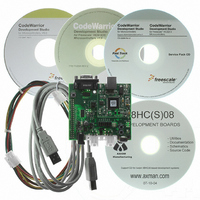DEMO9S08EL32 Freescale Semiconductor, DEMO9S08EL32 Datasheet - Page 351

DEMO9S08EL32
Manufacturer Part Number
DEMO9S08EL32
Description
BOARD DEMO FOR 9S08 EL MCU
Manufacturer
Freescale Semiconductor
Type
MCUr
Datasheets
1.DEMO9S08EL32.pdf
(356 pages)
2.DEMO9S08EL32.pdf
(14 pages)
3.DEMO9S08EL32.pdf
(2 pages)
Specifications of DEMO9S08EL32
Contents
Evaluation Board
Processor To Be Evaluated
MC9S08EL32
Data Bus Width
8 bit
Interface Type
RS-232, USB
Operating Supply Voltage
12 V
Silicon Manufacturer
Freescale
Core Architecture
HCS08
Core Sub-architecture
HCS08
Silicon Core Number
MC9S08
Silicon Family Name
S08EL
Rohs Compliant
Yes
For Use With/related Products
MC9S08EL32
Lead Free Status / RoHS Status
Lead free / RoHS Compliant
- Current page: 351 of 356
- Download datasheet (9Mb)
A.14 EMC Performance
Electromagnetic compatibility (EMC) performance is highly dependant on the environment in which the
MCU resides. Board design and layout, circuit topology choices, location and characteristics of external
components as well as MCU software operation all play a significant role in EMC performance. The
system designer should consult Freescale applications notes such as AN2321, AN1050, AN1263,
AN2764, and AN1259 for advice and guidance specifically targeted at optimizing EMC performance.
A.14.1
Microcontroller radiated RF emissions are measured from 150 kHz to 1 GHz using the TEM/GTEM Cell
method in accordance with the IEC 61967-2 and SAE J1752/3 standards. The measurement is performed
with the microcontroller installed on a custom EMC evaluation board while running specialized EMC test
software. The radiated emissions from the microcontroller are measured in a TEM cell in two package
orientations (North and East).
The maximum radiated RF emissions of the tested configuration in all orientations are less than or equal
to the reported emissions levels.
Freescale Semiconductor
1
2
3
4
Radiated emissions,
electric field
Num
The frequency of this clock is controlled by a software setting.
These values are hardware state machine controlled. User code does not need to count cycles. This information supplied for
calculating approximate time to program and erase.
Typical endurance for Flash is based upon the intrinsic bit cell performance. For additional information on how Freescale
defines typical endurance, please refer to Engineering Bulletin EB619/D, Typical Endurance for Nonvolatile Memory.
Typical data retention values are based on intrinsic capability of the technology measured at high temperature and de-rated
to 25°C using the Arrhenius equation. For additional information on how Freescale Semiconductor defines typical data
retention, please refer to Engineering Bulletin EB618/D, Typical Data Retention for Nonvolatile Memory.
10
11
Parameter
C
C
C
Radiated Emissions
EEPROM Program/erase endurance
Data retention
T
T
T = 25°C
L
L
to T
to T
H
H
MC9S08EL32 Series and MC9S08SL16 Series Data Sheet, Rev. 3
= –40°C to + 0°C
= 0°C to + 125°C
Characteristic
4
V
Symbol
RE_TEM
Table A-17. Radiated Emissions, Electric Field
Table A-16. Flash Characteristics (continued)
package type
Conditions
V
T
28 TSSOP
A
DD
= +25
= 5.0V
3
o
C
Symbol
n
t
D_ret
EEPE
500 – 1000 MHz
150 – 500 MHz
0.15 – 50 MHz
50 – 150 MHz
Frequency
SAE Level
IEC Level
10,000
50,000
Min
15
4MHz crystal
20MHz bus
f
OSC
100,000
Typical
100
Appendix A Electrical Characteristics
/f
BUS
Max
—
—
—
—
Level
(Max)
−10
N/A
11
12
3
2
1
cycles
years
Unit
dBμV
Unit
—
—
353
Related parts for DEMO9S08EL32
Image
Part Number
Description
Manufacturer
Datasheet
Request
R
Part Number:
Description:
Manufacturer:
Freescale Semiconductor, Inc
Datasheet:
Part Number:
Description:
Manufacturer:
Freescale Semiconductor, Inc
Datasheet:
Part Number:
Description:
Manufacturer:
Freescale Semiconductor, Inc
Datasheet:
Part Number:
Description:
Manufacturer:
Freescale Semiconductor, Inc
Datasheet:
Part Number:
Description:
Manufacturer:
Freescale Semiconductor, Inc
Datasheet:
Part Number:
Description:
Manufacturer:
Freescale Semiconductor, Inc
Datasheet:
Part Number:
Description:
Manufacturer:
Freescale Semiconductor, Inc
Datasheet:
Part Number:
Description:
Manufacturer:
Freescale Semiconductor, Inc
Datasheet:
Part Number:
Description:
Manufacturer:
Freescale Semiconductor, Inc
Datasheet:
Part Number:
Description:
Manufacturer:
Freescale Semiconductor, Inc
Datasheet:
Part Number:
Description:
Manufacturer:
Freescale Semiconductor, Inc
Datasheet:
Part Number:
Description:
Manufacturer:
Freescale Semiconductor, Inc
Datasheet:
Part Number:
Description:
Manufacturer:
Freescale Semiconductor, Inc
Datasheet:
Part Number:
Description:
Manufacturer:
Freescale Semiconductor, Inc
Datasheet:
Part Number:
Description:
Manufacturer:
Freescale Semiconductor, Inc
Datasheet:






